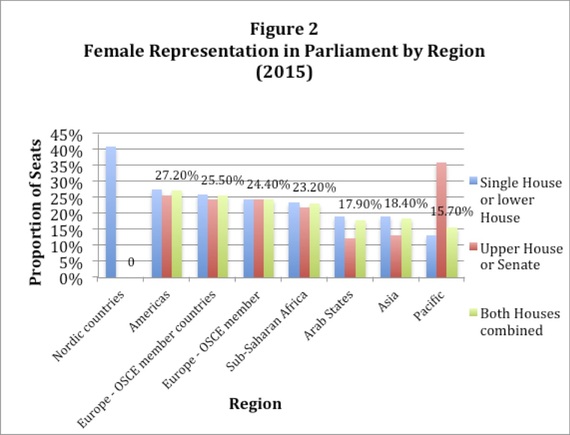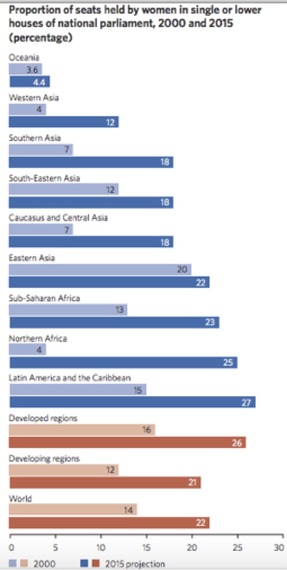Political participation of women is a global challenge. Half the world's population still faces numerous obstacles to participating in the political process. The Millennium Development Goals (MDGs) address this issue; Under Goal 3, (Promote gender equality and empower women), Target 3.3 states, "3.3 Proportion of seats held by women in national parliament" (MDG Report, 2015). As we enter into the new development framework comprising the Sustainable Development Goals (SDGs), it is important to evaluate women's political empowerment and the progress over the last two decades in an effort to close the gender gap in this important sector.
According to the latest MDG Report (2015), women have gained ground in parliamentary representation in nearly 90 per cent of the 174 countries with data over the past 20 years. During this period, the average proportion of women in parliament has nearly doubled. Figure 1 shows the changes in the levels of participation from 2000 to 2015 for the different regions. One of the biggest contributors towards increased political representation is the quota system, which operates in more than 120 countries. Despite this improvement, only one in five members are women.
Many countries have adopted some kind of quota system in order to level the playing field and enable women to enter this male-dominated field. According to the Quota Project: Global Database of Quotas for Women, which is a joint research project undertaken by the International IDEA, Stockholm University and the Inter-Parliamentary Union, half of the countries of the world today use some type of electoral quota for their parliament.
Electoral quotas are quite a debated topic. The Quota Project refers to three types of gender quotas; Reserved seats (constitutional and/or legislative), 2) Legal candidate quotas (constitutional and/or legislative) and 3) Political party quotas (voluntary). While reserved seats regulate the number of women elected, the other two forms set a minimum for the share of women on the candidate lists, either as a legal requirement (no. 2) or a measure written into the statutes of individual political parties (no. 3). (Quota Project)Worldwide, the global average of women in parliaments is now (2015) at 22.6 percent, up from 11.3 percent in 1995. This represents a gain of 10 percentage points in 15 years. Rwanda is now the world leader in terms of women's parliamentary representation with women occupying 63.8 percent of the seats in the lower house. This is a sharp but positive contrast to the world average of 22.6 percent. The world average is three times and is quite unsatisfactory given that half of the world's population is women.
Regionally, the Nordic countries enjoy the highest percentage of women's representation at 41.1 percent in the single/lower house, while Pacific countries only have 13.1 percent of women in both houses. See Figure 2, which highlights the proportion of seats held by women in parliaments (Data Labels represent both houses).
 It is important however to differentiate between representation and effective participation. The 2015 MDG report highlights, "However, a significant slowdown in progress since 2014 could be an indicator that the 'fast-track' impact of gender quotas has reached its peak. This calls for additional measures to advance women's political empowerment. While reserved seats act as a perfect tool for increasing the proportion of seats held by women, reserved seats play a limited role in achieving effective contribution or empowerment of these women legislators.
It is important however to differentiate between representation and effective participation. The 2015 MDG report highlights, "However, a significant slowdown in progress since 2014 could be an indicator that the 'fast-track' impact of gender quotas has reached its peak. This calls for additional measures to advance women's political empowerment. While reserved seats act as a perfect tool for increasing the proportion of seats held by women, reserved seats play a limited role in achieving effective contribution or empowerment of these women legislators.
Additionally, it is important that alongside electing women into parliaments, there is a need to create gender-sensitive parliaments. This means that women have access to the parliament, they are equally represented across all parliamentary structures, including committees, and there is positive working culture within parliament as well as effective engagement with political parties on gender equality. The MDG report also highlights that progress in leadership positions has been slow; just 16 per cent of parliamentary leaders (speakers of parliament) are women, while women represent 18 per cent of all government ministers in the world, an increase of only 4 percentage points since 2005.
Baldez (2006) shares the concerns surrounding quotas and highlights that the benefits of gender quotas must be analyzed in terms of the broader political context, not solely in terms of their impact on women but also in terms of how they interact with other aspects of the electoral process. Citing Latin America as an example, she suggests that, "Gender quota laws strengthen highly centralized, undemocratic processes of candidate nomination." In another paper, Nanivadekar (2006) uses the Indian evidence of reserved seats to highlight that quotas by itself are not enough to achieve meaningful participation of women across all sectors and ensure gender equality in politics.
As we enter a new phase of global development, we need a development framework that will guide us for the next 15 years and play a more effective role in closing the gender gap in politics not just through representative but also through meaningful participation. The Sustainable Development Goals has prioritized this issue. Under SDG 5, Achieve Gender Equality and Empower all Women and Girls, Target 5.5 states, "Ensure women's full and effective participation and equal opportunities for leadership at all levels of decision-making in political, economic and public life." (SDG, 2015)
References1.Baldez, Lisa (2006). "The Pros and Cons of Gender Quota Laws: What Happens When You Kick Men Out and Let Women In?" Dartmouth College. Critical Perspectives on Gender and Politics, Politics & Gender, 2, 101-128. Printed in the U.S.A.
2.Nanivadekar, Medha. (2006) "Are Quotas a Good Idea? The Indian Experience with Reserved Seats for Women," Shivaji University. Critical Perspectives on Gender and Politics, Politics & Gender, 2, 101-128. Printed in the U.S.A.

